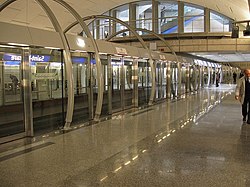| Revision as of 22:22, 6 September 2005 editRdsmith4 (talk | contribs)Extended confirmed users23,841 editsm Reverted edits by 24.26.240.30 to last version by Ish warsaw← Previous edit | Revision as of 23:46, 6 September 2005 edit undo24.26.240.30 (talk)No edit summaryNext edit → | ||
| Line 1: | Line 1: | ||
| ]) |
]). | ||
| A '''metro station''' is a ] for a ]. It is often underground or elevated. At crossings of metro lines they are multi-level. | |||
| At street level the ] of the metro company marks the entrance of the station (often a large "M"; for ]'s circle with a horizontal bar through the center, see the picture there). | |||
| Often there are several entrances for one station, saving one from having to cross the street. In such a case, tunnels or overhead stations can often also be used just to cross the street. | |||
| In some cases metro stations can be connected to important buildings by a direct enclosed hallway (see ]). | |||
| Some metro systems, such as those of ], ], and ], are famous for the beautiful ] and ] in their metro systems.] in ], ]. The ] is one of the most modern underground railway systems in Europe.]] | Some metro systems, such as those of ], ], and ], are famous for the beautiful ] and ] in their metro systems.] in ], ]. The ] is one of the most modern underground railway systems in Europe.]] | ||
Revision as of 23:46, 6 September 2005
[[image:Madrid-metro-1.jpg|frame|250px|Exterior open to important buildings by a direct enclosed hallway (see underground city).
Some metro systems, such as those of Montreal, Stockholm, and Moscow, are famous for the beautiful architecture and public art in their metro systems.]
Metro stations, more so than railway and bus stations, often have a characteristic artistic design that can identify each stop. Some have sculptures or frescos. For example, London's Baker Street station is adorned with tiles depicting Sherlock Holmes. Every metro station in Valencia, Spain has a different sculpture on the ticket-hall level. Alameda station is decorated with fragments of while tile, like the dominant style of the Ciutat de les Arts i les Ciències. Each station of the Red Line subway in Los Angeles was built with different artwork and decorating schemes, such as murals, tile artwork and sculptural benches. This isn't always the case, however. Sir Norman Foster's relatively young system in Bilbao, Spain uses the same modern architecture at every station to make navigation easier for the passenger, though some may argue that this is at the expense of character.

In some stations, especially where trains are fully automated, the entire platform is sometimes screened from the track by a wall, typically of glass, with automatic platform-edge doors (PEDs). These open, like elevator doors, only when a train is stopped, and thus eliminate the hazard that a passenger will accidentally fall (or deliberately jump) onto the tracks and be run over or electrocuted. Control over ventilation of the platform is also improved, allowing it to be heated or cooled without having to do the same for the tunnels. The doors, however, add cost and complexity to the system, and trains may have to approach the station more slowly so they can stop in accurate alignment with them.
See also

- Metro
- List of metro systems
- Bus stop
- Train station
- Railway platform
- Passenger behavior in Shanghai
- List of transport topics
- In a Station of the Metro (poem)
External links
- UrbanRail.Net (formerly called metroPlanet) – descriptions of all metro systems in the world, each with a schematic map showing all stations.
- Metro Bits Arts and architecture of metro stations around the world.